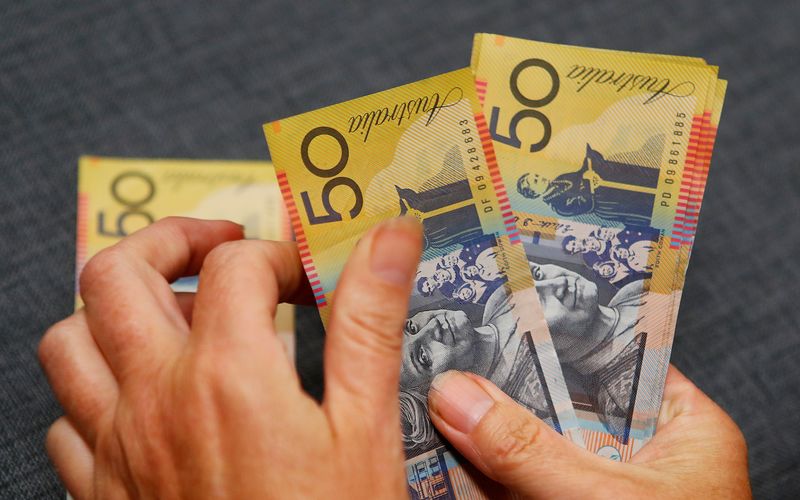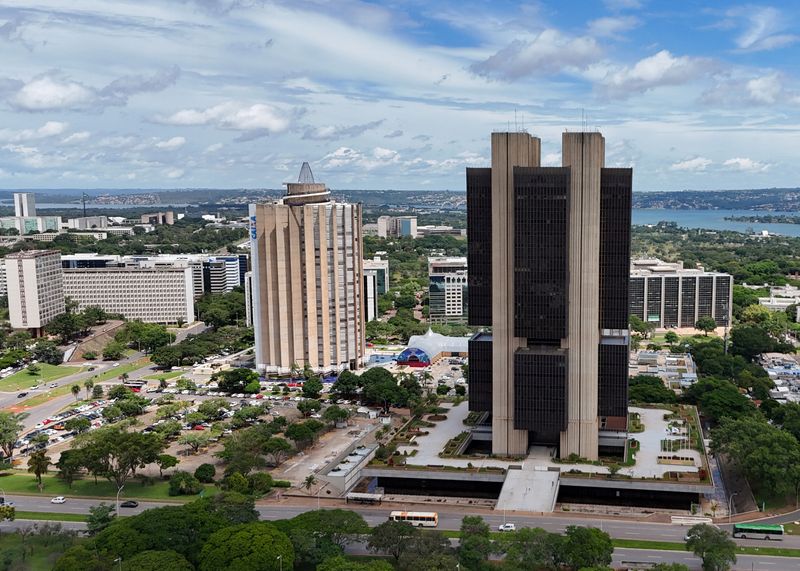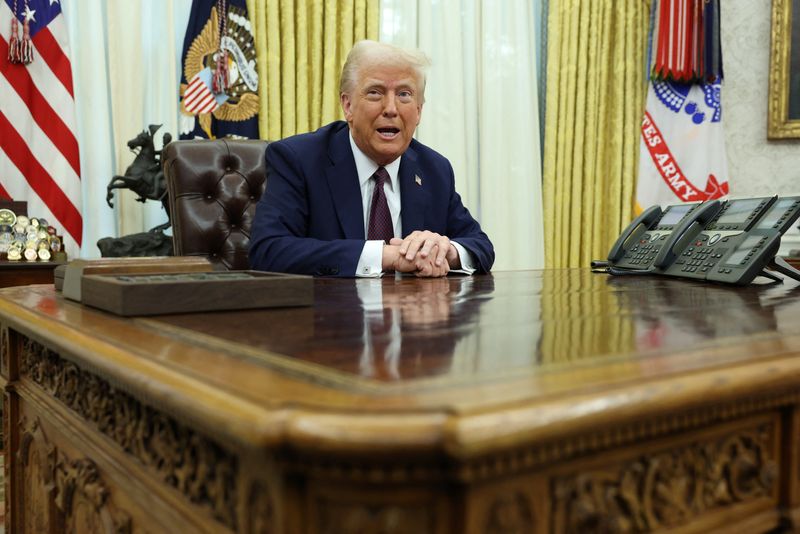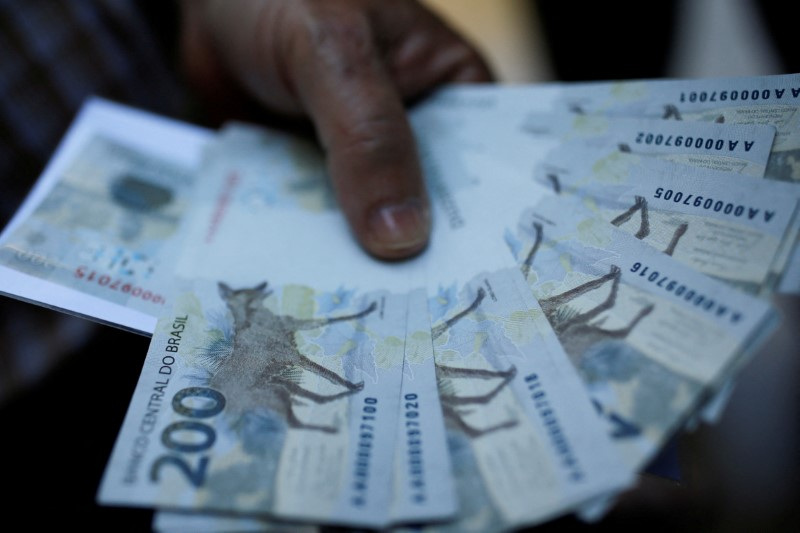Select Language

By Rae Wee
SINGAPORE (Reuters) -The yuan sank on Wednesday as a new Sino-U.S. trade war shook Chinese markets returning from an extended Lunar New Year break, while the yen jumped on rising bets of further Bank of Japan (BOJ) rate hikes this year.
The dollar rose more than 0.5% against the yuan to a high of 7.2856 shortly after onshore trading opened despite the People's Bank of China (PBOC) setting a stronger-than-expected yuan midpoint rate, around which the currency is allowed to trade in a 2% band.
The fixing had been closely watched by investors for clues on whether Beijing would allow for a weaker currency to blunt the impact of sweeping new tariffs imposed by U.S. President Donald Trump.
China on Tuesday slapped tariffs on U.S. imports in a swift response to the U.S. duties on Chinese goods, and Trump said the same day he is in no hurry to speak to Chinese President Xi Jinping to try to defuse a new trade war between the world's two largest economies.
"Our base case is that China will increase its tolerance for currency weakness in response to the U.S. tariffs," said Carol Kong, a currency strategist at Commonwealth Bank of Australia (OTC:CMWAY) (CBA).
"I think ultimately, allowing the yuan to weaken will be one of the responses China takes, and I would expect further retaliation from China if the U.S. retaliates with even more tariffs."
The offshore yuan was little changed at 7.2892 per dollar on Wednesday, after falling to a record low of 7.3765 per dollar at the start of the week.
The Australian dollar, often used as a liquid proxy for the yuan, was a touch weaker at $0.6247, though was still clinging on to its 0.47% overnight gain. Its New Zealand counterpart last fetched $0.5653.
In the broader market, volatility in currencies eased a little after a turbulent start to the week following Trump's imposition of steep tariffs on top U.S. trading partners, with those on Mexico and Canada having since been delayed following negotiations.
The dollar was on the back foot, giving some respite to heavily battered currencies like the euro, which bounced back above the $1.02 level and last bought $1.0374.
The yen was a notable mover in the Asian session as it rose more than 0.5% to its highest in over a month at 153.47 per dollar. The impetus came from data that showed Japan's December inflation-adjusted real wages rose 0.6% year-on-year thanks to a wintertime bonus bump, with government officials expressing optimism that wage hike momentum is growing.
That left traders ramping up bets of more BOJ rate hikes this year, with just over 30 basis points priced in by the year-end.
"The upcoming spring wage rounds will be closely watched, as expectations grow of more BOJ tightening," said Alvin Tan, head of Asia FX strategy at RBC Capital Markets.
"As we have seen for more than a year, BOJ tightening by itself is not adequate to drive the yen into an appreciation trend, but that along with the yen's under-valuation might be enough to cap yen weakness particularly in a more uncertain global macro environment."
Elsewhere, the Canadian dollar rebounded from Monday's 22-year low and last stood at C$1.4331.
The Mexican peso was steady at 20.4840 per dollar, moving away from a trough of 21.2882 hit on Monday, its weakest level in nearly three years.
Sterling was similarly a touch higher at $1.2484, while the dollar index fell 0.07% to 107.97.
"I am actually quite surprised at the resilience of markets. Risk sentiment...has been quite positive despite all the tariff headlines and the resumption of the U.S.-China trade war," said CBA's Kong.
"I think part of the optimism stems from the fact that the U.S. was willing to delay tariffs as long as the other countries gave Trump what he wanted."

Investing.com-- U.S. stock index futures fell on Tuesday evening, pressured chiefly by losses in technology stocks as underwhelming earnings from Google owner Alphabet raised more questions about artificial intelligence demand.
Futures retreated after a positive session on Wall Street, as investors were relieved by President Donald Trump postponing plans to impose steep trade tariffs on Canada and Mexico. But Trump’s tariffs on China still took effect, drawing ire and retaliation from Beijing.
Concerns over a brewing trade war had battered Wall Street on Monday, with U.S. stock benchmarks still struggling to recover from those losses.
S&P 500 Futures fell 0.4% to 6,042.25 points, while Nasdaq 100 Futures fell 0.5% to 21,569.0 points by 19:05 ET (00:05 GMT). Dow Jones Futures fell 0.1% to 44,642.0 points.
Alphabet slides as Q4 earnings underwhelm
Alphabet’s class A shares (NASDAQ:GOOGL) slid 7.4% in aftermarket trade, after the company’s fourth-quarter revenue missed expectations, especially on disappointing earnings from its cloud division, which is closely tied to AI.
The print raised questions about just how much of an earnings driver AI was, following a similar pattern from peer Microsoft’s earnings last week. Alphabet, like Microsoft (NASDAQ:MSFT), signaled that it will spend vast amounts of capital on AI in 2025.
Wall Street’s AI spending has come under heightened scrutiny in recent weeks, especially with the release of China’s DeepSeek R1 AI model, which appeared to operate on a substantially smaller budget.
This had triggered a massive rout in tech valuations last week, one that Wall Street is still struggling to recover from. Alphabet’s earnings could trigger a fresh tech rout, although the company’s Wall Street peers were largely unchanged in aftermarket trade.
Wall St shrugs off China trade jitters; more earnings awaited
Wall Street indexes ended Tuesday’s session higher, aided by a round of dip buying after steep losses on Monday.
Investors largely looked past a brewing trade war with China, after Trump’s 10% tariffs against the country took effect. Beijing retaliated with its own import tariffs and export controls, and also launched an antitrust investigation into Google.
Trump signaled that he was in no hurry to negotiate with Chinese President Xi Jinping, with the tariffs now set to remain in place for the foreseeable future.
Analysts warned that increased trade tariffs- which will be borne by U.S. importers, could underpin inflation and pressure growth.
The S&P 500 rose 0.7% to 6,037.83 points, while the NASDAQ Composite rose 1.4% to 19,654.02 points on Tuesday. The Dow Jones Industrial Average rose 0.3% to 44,556.04 points.
More major earnings are on tap this week, with magnificent seven member Amazon.com Inc (NASDAQ:AMZN) set to report on Thursday. Before that, prints from Uber Technologies Inc (NYSE:UBER), Walt Disney Company (NYSE:DIS), Qualcomm Incorporated (NASDAQ:QCOM), and MicroStrategy Incorporated (NASDAQ:MSTR) are due on Wednesday.

By Marcela Ayres
BRASILIA (Reuters) - Brazil's Treasury on Tuesday estimated that federal public debt will rise up to 16% this year, as bonds linked to the benchmark interest rate potentially exceed half of total debt, exposing them to the central bank's aggressive push to tame inflation and making it costlier for the country to service its debts.
The Treasury's annual financing plan sees debt ranging from 8.1 trillion reais to 8.5 trillion reais ($1.47 trillion) in 2025, up from the 7.316 trillion reais recorded in December.
It also stressed the continued strategy of issuing conventional and sustainable bonds to provide a reference for the Brazilian sovereign yield curve, adding it "may use external liability management operations to enhance the efficiency of the yield curve."
The Treasury estimated that the share of debt linked to the benchmark Selic interest rate will account for 48% to 52% of the total this year, after rising to 46.3% in 2024.
These floating-rate bonds, known as LFTs, reached their highest share in 20 years last year, amid intense volatility from shifting interest rate expectations in the U.S. and concerns over Brazil's growing indebtedness.
According to Treasury Secretary Rogerio Ceron, the strategy of increasing the share of floating-rate bonds aligns with market appetite.
"There is no point in working against market demand," he said at the press conference.
Such securities are typically more appealing to investors during periods of heightened risk perception but leave debt costs vulnerable to sharp increases when interest rates go up.

SEOUL (Reuters) - A voting board member, Shin Sung-hwan, who dissented in the Bank of Korea's decision to keep policy rates unchanged in January, said the economy faces bigger risks due to domestic political turmoil and U.S. policy changes, minutes from the bank's meeting showed on Tuesday.
The Bank of Korea on Jan. 16 unexpectedly voted 6-1 to keep its policy interest rate unchanged and signalled it needed to wait for the domestic political turmoil weighing on the currency to stabilise before it could make further rate cuts.
Only Shin voted to cut interest rates by 25 basis points on Jan. 16, when the bank decided to keep its benchmark interest rate unchanged at 3.00%.
Most, including Shin, said the bank should be open to near-term policy easing in the face of increased political and external uncertainties as South Korea continues to grapple with the worst political turmoil in decades after impeached President Yoon Suk Yeol's brief imposition of martial law.
They also cited uncertainties related to U.S. President Donald Trump's trade policies, describing this as clouds hanging over the trade-reliant nation.
"It is desirable to cut the interest rate after examining the effect of the last two interest rate cuts and observing the policy direction of the new U.S. government, as well as the U.S. Federal Reserve's interest rate decision, and the political and economic situation at home and abroad," one of the board members said.
Only dissenters were identified in the minutes.
South Korea's exports fell in January for the first time in 16 months and at the sharpest pace in a year and a half due to U.S. tariff uncertainty and an unfavourable calendar effect, preliminary data released on Saturday showed.

By Trevor Hunnicutt and Kevin Huang
WASHINGTON/BEIJING (Reuters) -China on Tuesday slapped tariffs on U.S. imports in a swift response to new U.S. duties on Chinese goods, renewing a trade war between the world's top two economies as President Donald Trump sought to punish China for not halting the flow of illicit drugs.
Trump's additional 10% tariff across all Chinese imports into the U.S. came into effect at 12:01 a.m. ET on Tuesday (0501 GMT).
Within minutes, China's Finance Ministry said it would impose levies of 15% for U.S. coal and LNG and 10% for crude oil, farm equipment and some autos. The new tariffs on U.S. exports will start on Feb. 10, the ministry said.
China also said it was starting an anti-monopoly investigation in Alphabet (NASDAQ:GOOGL) Inc's Google, while including both PVH Corp (NYSE:PVH), the holding company for brands including Calvin Klein, and U.S. biotechnology company Illumina (NASDAQ:ILMN) on its "unreliable entities list".
Separately, China's Commerce Ministry and its Customs Administration said it is imposing export controls on tungsten, tellurium, ruthenium, molybdenum and ruthenium-related items to "safeguard national security interests". China controls much of the world's supply of such rare earths that are critical for the clean energy transition.
Trump on Monday suspended his threat of 25% tariffs on Mexico and Canada at the last minute, agreeing to a 30-day pause in return for concessions on border and crime enforcement with the two neighbouring countries.
But there was no such reprieve for China, and a White House spokesperson said Trump would not be speaking with Chinese President Xi Jinping until later in the week.
During his first term in 2018, Trump initiated a brutal two-year trade war with China over its massive U.S. trade surplus, with tit-for-tat tariffs on hundreds of billions of dollars worth of goods upending global supply chains and damaging the world economy.
To end that trade war, China agreed in 2020 to spend an extra $200 billion a year on U.S. goods but the plan was derailed by the COVID pandemic and its annual trade deficit had widened to $361 billion, according to Chinese customs data released last month.
"The trade war is in the early stages so the likelihood of further tariffs is high," Oxford Economics said in a note as it downgraded its China economic growth forecast.
Trump warned he might increase tariffs on China further unless Beijing stemmed the flow of fentanyl, a deadly opioid, into the United States.
"China hopefully is going to stop sending us fentanyl, and if they're not, the tariffs are going to go substantially higher," he said on Monday.
China has called fentanyl America's problem and said it would challenge the tariffs at the World Trade Organization and take other countermeasures, but also left the door open for talks.
Stocks in Hong Kong pared gains after China's retaliation.
“Unlike Canada and Mexico, it is clearly harder for the U.S. and China to agree on what Trump demands economically and politically. The previous market optimism on a quick deal still looks uncertain," said Gary Ng, senior economist at Natixis in Hong Kong.
"Even if the two countries can agree on some issues, it is possible to see tariffs being used as a recurrent tool, which can be a key source of market volatility this year."
NEIGHBOURLY DEALS
There was relief in Ottawa and Mexico City, as well as global financial markets, after the deals to avert the hefty tariffs on Canada and Mexico.
Both Canadian Prime Minister Justin Trudeau and Mexican President Claudia Sheinbaum said they had agreed to bolster border enforcement efforts in response to Trump's demand to crack down on immigration and drug smuggling. That would pause 25% tariffs due to take effect on Tuesday for 30 days.
Canada agreed to deploy new technology and personnel along its border with the United States and launch cooperative efforts to fight organized crime, fentanyl smuggling and money laundering.
Mexico agreed to reinforce its northern border with 10,000 National Guard members to stem the flow of illegal migration and drugs.
The United States also made a commitment to prevent trafficking of high-powered weapons to Mexico, Sheinbaum said.
"As President, it is my responsibility to ensure the safety of ALL Americans, and I am doing just that. I am very pleased with this initial outcome," Trump said on social media.
Canadian industry groups, fearful of disrupted supply chains, welcomed the pause.
"That's very encouraging news," said Chris Davison, who heads a trade group of Canadian canola producers. "We have a highly integrated industry that benefits both countries."
Trump suggested on Sunday the 27-nation European Union would be his next target, but did not say when.
EU leaders at an informal summit in Brussels on Monday said Europe would be prepared to fight back if the U.S. imposes tariffs, but also called for reason and negotiation. The U.S. is the EU's largest trade and investment partner.
Trump hinted that Britain, which left the EU in 2020, might be spared tariffs.
Trump acknowledged over the weekend that his tariffs could cause some short-term pain for U.S. consumers, but says they are needed to curb immigration and narcotics trafficking and spur domestic industries.
The tariffs as originally planned would cover almost half of all U.S. imports and would require the United States to more than double its own manufacturing output to cover the gap - an unfeasible task in the near term, ING analysts wrote.
Other analysts said the tariffs could throw Canada and Mexico into recession and trigger "stagflation" - high inflation, stagnant growth and elevated unemployment - at home.

Investing.com– Asian stocks bounced back on Tuesday after U.S. President Donald Trump postponed trade tariffs on Canada and Mexico, easing some market concerns, though caution persisted ahead of the impending tariffs on Chinese imports.
Regional equities recovered most of the ground after steep declines on Monday, which stemmed from Trump’s tariff announcement.
U.S. stock index futures were also higher in Asian trade after Wall Street ended lower on Monday.
Asia stocks jump as tariff delays ease immediate concerns
Trump had announced a 25% tariff on imports from Canada and Mexico, alongside a 10% levy on Chinese goods, effective February 4.
However, following discussions with Canadian and Mexican counterparts, Trump agreed to postpone the tariffs on Mexico and Canada by 30 days.
Asian stocks were higher as the postponement eased immediate trade war concerns and reduced the risk of supply chain disruptions.
Markets also view the delay as a potential window for further negotiations, reducing uncertainty in the short term.
Japan’s Nikkei 225 index jumped 1.5%, while TOPIX rose 1.4%.
South Korea’s KOSPI index climbed 1.8%, rebounding from its lowest level since early January.
Australia’s S&P/ASX 200 index gained 0.4%, while Philippine’s PSEi Composite jumped 2%.
Elsewhere, Futures for Nifty 50 indicated a marginal rise at open, while Thailand’s SET Index fell 0.8%, bucking the regional trend.
Chinese tariffs still on tap; Hong Kong stocks surge on AI optimism
Chinese markets were closed for the Lunar New Year holiday and will resume trade on Wednesday this week.
The implementation of U.S. tariffs on Chinese imports was still scheduled to take effect later in the day.
However, markets shrugged off most concerns about levies on China, in anticipation of future negotiations and local stimulus measures.
Additionally, with only the 10% tariff set to take effect, investors anticipate less severe economic fallout than initially feared.
This sentiment was reflected in Hong Kong stocks, with Hang Seng index jumping 3% on Monday.
Hong Kong-listed Chinese tech stocks surged on optimism around local artificial intelligence (AI) models like DeepSeek and Alibaba's (HK:9988) Qwen.
Semiconductor Manufacturing International Corp (HK:0981) (SMIC) shares led the gains with a 7.2% rise, while Xiaomi (HK:1810) and Alibaba stock rose 5%, each.

Investing.com -- President Donald Trump is set to pause tariffs on Canada for 30 days on following a call with Canadian Prime Minister Justin Trudeau in which the two leaders struck a deal to reinforce the U.S.-Canada border and implement measures to stem the flow of illegal drugs in the United States.
Trump's proposed tariffs of 25% on imported goods from Canada goods, which was set to come into effect on Tuesday, "will be paused for at least 30 days while we work together," Prime Minister Justin Trudeau said on Monday.
The updates comes on heels of Trump reportedly saying that the call with Trudeau went "very well."
Mexico struck a similar concession with Trump earlier Monday, also averting a 25% tariff that was set for Tuesday. Attention now turns to the U.S.-China call, which Trump said should get underway over the next 24 hours. Ahead of the call Trump warned that he could hike tariffs on China beyond the 10% levy he announced on Sunday, but markets are hoping that the two nations can agreed to measures that would avoid another U.S.-China trade war.

SAO PAULO - Brazil's real closed trading on Monday stronger versus the U.S. dollar for the 11th consecutive session, marking its longest streak of gains since April 2005.
The Brazilian currency closed at 5.8159 reais per greenback, the strongest since Nov. 26, when it closed at 5.8096 reais per dollar.
It weakened more than 1% against the dollar in early morning trading on Monday before reversing those losses after U.S. President Donald Trump agreed to pause tariffs on Mexico for a month, with the real closing 0.3% stronger.
Brazil's real weakened more than 20% last year against the U.S. dollar, after a sell-off in the final months of 2024 drove the Latin America currency to its weakest-ever amid investor distrust of the Brazilian government's fiscal policy and an outflow of resources.
Year-to-date, the Brazilian real has strengthened by nearly 6%.

Among industrial metals, benchmark copper futures on the London Metal Exchange fell 1.1% to $8,944.25 a ton, while March copper futures fell 1.9% to $4.1960 a pound.
Copper was also pressured by softer-than-expected private purchasing managers index data from top importer China, as business activity remained soft in the first month of 2025.
JPMorgan reiterates bull case for gold
JPMorgan analysts said in a Monday note that they maintained their bullish view on gold in the medium-term, stating that risk aversion in broader markets could still drive investors into the yellow metal.
The investment bank still expects gold to rise to $3,000 an ounce by late-2025, stating that lower U.S. interest rates and a stabler, albeit slower economy, will drive flows into the yellow metal.
JPM is set to deliver about $4 billion worth of gold against futures contracts in February. The investment bank is by far the largest dealer of gold in the world.

Investing.com-- Gold prices fell from record highs on Monday, coming under pressure from a sharp rise in the dollar after U.S. President Donald Trump imposed trade tariffs on China, Canada, and Mexico.
But the yellow metal’s decline is expected to be short-lived, given that it was sitting on a strong run-up over the past week, as a rout in global equity markets and anticipation of Trump’s tariffs ramped up safe haven demand.
The dollar surged to a near one-month high, and was back in sight of an over two-year peak after the tariffs were confirmed.
Spot gold fell 0.7% to $2,780.56 an ounce, while gold futures expiring in April fell 0.8% to $2,810.30 an ounce by 23:38 ET (04:38 GMT). Spot prices hit a record high of $2,817.57 an ounce last week.
Gold pressured by dollar spike as tariffs point to higher inflation
Trump imposed 25% tariffs on Canadian and Mexican imports, along with a 10% duty on China. All three countries balked at the tariffs and vowed retaliation.
Trump had largely telegraphed the tariffs last week, before signing an executive order imposing them on Saturday. The tariffs will take effect from Tuesday.
The dollar rose sharply on the tariff news, pressuring metal markets.
Analysts were seen warning that the trade tariffs were likely to factor into higher U.S. inflation, giving the Federal Reserve less impetus to cut interest rates further. This could diminish gold’s long-term prospects, despite strong near-term safe haven demand.
Other precious metals retreated on this notion. Platinum futures fell 1.9% to $1,024.0 an ounce, while silver futures fell 1.5% to $31.795 an ounce. Both metals, like gold, had also risen sharply last week.
Among industrial metals, benchmark copper futures on the London Metal Exchange fell 1.1% to $8,944.25 a ton, while March copper futures fell 1.9% to $4.1960 a pound.
Copper was also pressured by softer-than-expected private purchasing managers index data from top importer China, as business activity remained soft in the first month of 2025.
JPMorgan reiterates bull case for gold
JPMorgan analysts said in a Monday note that they maintained their bullish view on gold in the medium-term, stating that risk aversion in broader markets could still drive investors into the yellow metal.
The investment bank still expects gold to rise to $3,000 an ounce by late-2025, stating that lower U.S. interest rates and a stabler, albeit slower economy, will drive flows into the yellow metal.
JPM is set to deliver about $4 billion worth of gold against futures contracts in February. The investment bank is by far the largest dealer of gold in the world.

